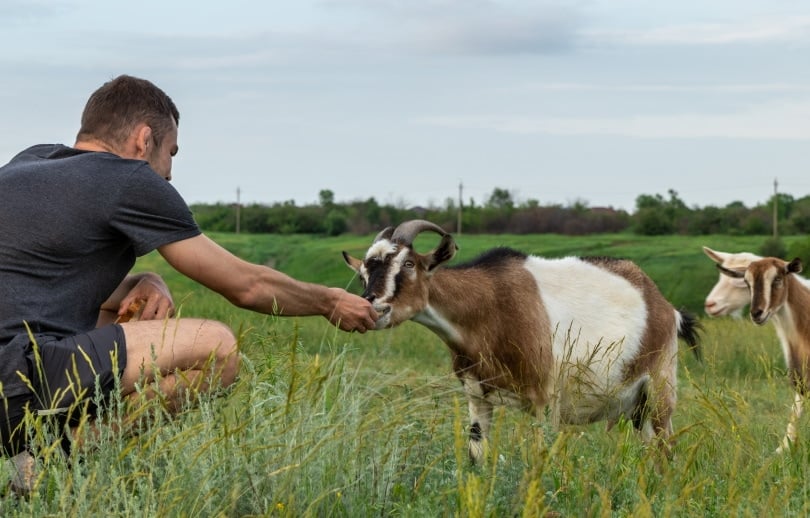Goats are one of the most popular and beloved animals in the barnyard. They are often on display at petting zoos and are the subjects of hilarious internet videos. It’s easy to fall in love with these unique, curious, and intelligent animals.
Whether you are a farmer, looking into farming, or are simply interested in owning a herd of goats, there are plenty of benefits that come with raising them. Read along as we discuss all the benefits of raising goats and go over some of the most popular goat breeds in the country and what they are most often used for.

The 10 Amazing Benefits of Raising Goats
1. They Are Excellent for Weed Control
Goats love munching on various weeds and vegetation, making them excellent natural landscapers. They will help clear the yard of unwanted vegetation including weeds, overgrown brush, shrubs, poison ivy, poison sumac, leaves, pine needles, and even bark. This keeps your land well-maintained without having to use harmful pesticides.
Not only do they help clear the area, but they also have an enzyme in their saliva that can neutralize several types of seeds, preventing the seeds from being able to grow after passing through their system. This will reduce the number of seeds in the soil, thus reducing the number of unwanted plants.
A herd of goats can cover quite a bit of land area in a short period of time. They are so effective at clearing land that they now have a term for using goats for weed management: “goat scaping.” Not only do farmers and property owners take advantage of goats’ eating habits, but businesses and city governments have turned to goats for vegetation control of large areas.
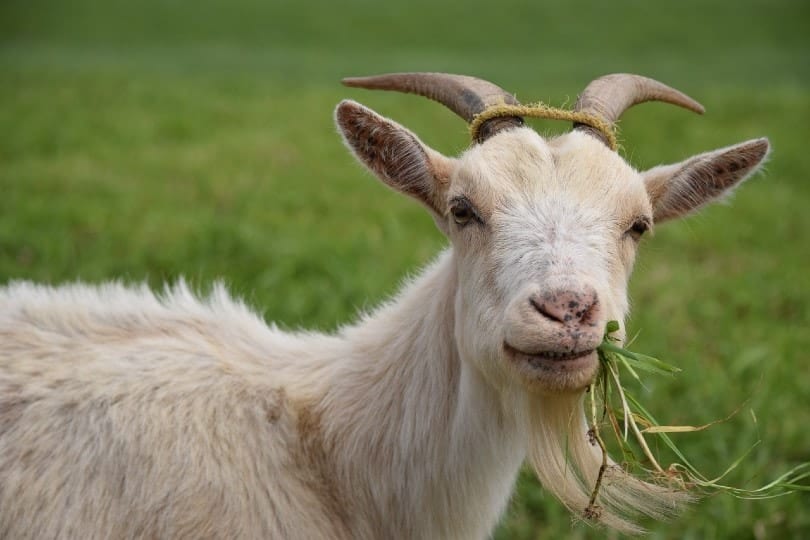
2. They Are Inexpensive and Easy to Keep
Goats have often been referred to as the gateway to farming. These animals are very versatile, easy to keep, require less space, and inexpensive to purchase and care for. They are considered much easier to raise than other forms of livestock. There are also plenty of goat breeds available to suit your specific needs.
Goats will require adequate shelter, heavy-duty fencing, and plenty of pasture space to forage on vegetation. Their nutritional needs will be dependent on their breed, size, age, and purpose. The climate will also play a key role in their dietary needs because areas that experience colder winters will drastically reduce their foraging, which makes up a large portion of their diet.
They are generally healthy animals and typically don’t require much more than basic healthcare if maintained properly. They are great starter animals for those that are interested in growing their farming practices. It can give a glimpse of what it’s like to care for livestock and rear them for a specific purpose without the expense and challenges that other species will have.
3. You Can Produce Your Own Dairy
If you have an interest in dairy production, goats are a great place to start. Dairy goats can produce quite a bit of milk, which can be used for a variety of purposes. Goat milk is much more expensive and difficult to find in the supermarket than cow’s milk.
It is also much easier to digest and has plenty of additional health benefits. Raising dairy goats allows you to have control over your own milk supply and opens up your ability to make goat cheese, yogurt, or even kefir.
Goat milk can also be used in a wide range of recipes and is often used in homemade natural soaps, too. The most common breeds kept as dairy goats are the Nubian, Nigerian Dwarf, Alpine, Saanen, Sable, Toggenburg, LaMancha, and Oberhasli.
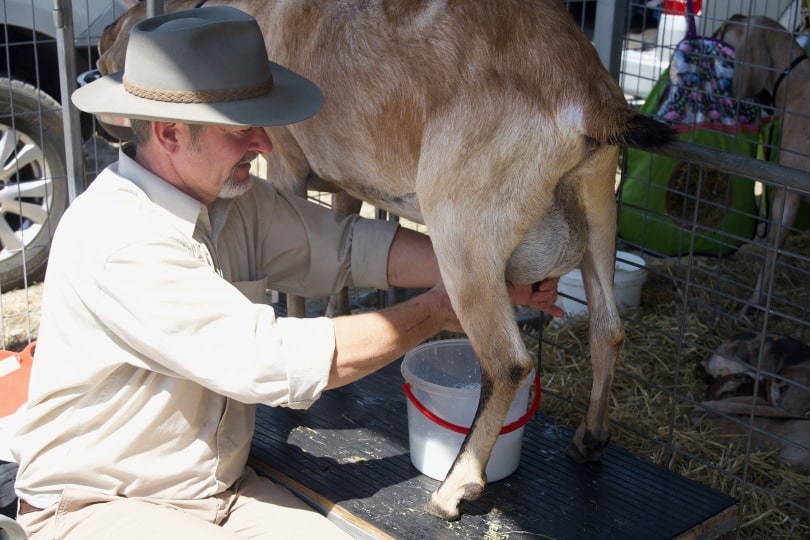
4. They Can Be Raised for Meat
Goat meat isn’t popularly consumed in the American diet but is very popular in cultures throughout the world. Asian, African, Caribbean, and Middle Eastern cultures commonly use goats in their cuisine. Raising your own meat sources can also give you the comfort of knowing that the animals are disease free and humanely raised.
Goat meat is not as easy to find in grocery stores across the United States, if you raise meat goats you can always choose to sell any meat that you don’t plan on using. Goat meat is very nutritious. It is rich in the protein iron, riboflavin, vitamin B12, zinc, and potassium.
Goat meat is also very lean and makes a healthy alternative to traditional red meats. It is low in saturated fat and cholesterol and is considered nutritionally superior to beef, pork, lamb, and chicken. The most popular meat goat is the Boer, but farmers use a variety of breeds for this purpose.
5. They Can Generate Extra Income
Goats are a very versatile form of livestock that can be raised for various purposes, some of which can help you generate extra income. If you raise dairy or meat goats, you can choose to start your very own business from your efforts.
Certain breeds are also used for fiber production, which can be cut from live goats. The Angora breed is popularly used for cashmere and mohair, which are quite popular in the clothing industry. Goat milk soap is also extremely popular and is often seen for sale online, and at local events like festivals or fairs.
If you have the space, the time, and a few different farm animal species, you could also consider starting a petting zoo. Many parents enjoy taking their kids to interact with farm animals for entertainment and education, so you could consider opening up your farm for this type of purpose.
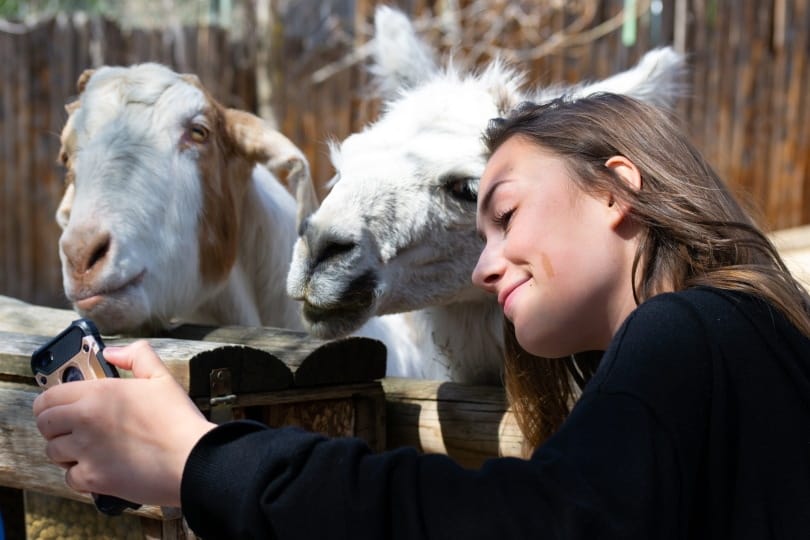
6. You Can Use Their Manure
Goat manure can make an excellent fertilizer for your yard and garden. Since it is in pellet form, the manure is less messy and easier to collect. Goat manure can aid in soil quality and help produce healthier crops and higher yields.
Another great thing about goat manure is that it doesn’t have the intense odor of horse or cow manure and it will not attract flies and other insects. You can even add it to compost and mix it in with other organic materials like kitchen scraps, egg shells, leaves, or grass clippings.
7. They’re Great for 4H and FFA
Goats are great animals to use in education programs like 4H and the Future Farmers of America (FFA). These organizations teach youth about work ethic and leadership skills, and get them familiar with agricultural practices.
Both 4H and the FFA will teach children how to properly care for these animals and highlight the importance of farming practices in our society. These are great programs for building confidence and learning a wide variety of life skills. They also get to build relationships with their animals and fellow peers.
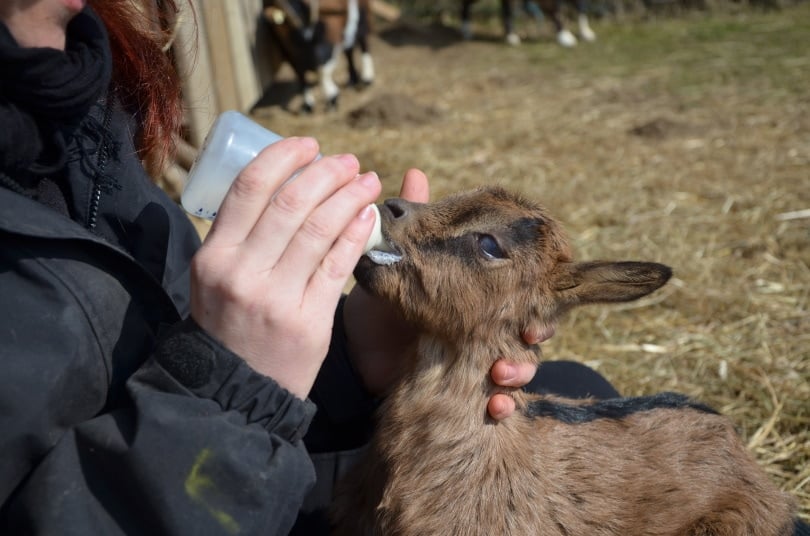
8. They Are Excellent Companions
Goats can turn out to be excellent companions, not just for people but for other farm animals, too. They are very inquisitive, playful, and social animals and should never be kept alone. They can develop strong relationships with their humans, especially if you take the time to develop a connection with them.
Goats are often kept in the pasture with other livestock like horses, donkeys, cattle, and sheep. These are all herd animals that will develop bonds with one another. Not only is it heartwarming but it’s also very beneficial for your pasture because the goats will eat the vegetation that the grazers leave behind.
9. They Can Double as Pack Animals
The use of pack animals may have deteriorated in most parts of the world thanks to advancements in technology and machinery, but goats make excellent pack animals for carrying cargo and goods to assist with hunting, hiking, and camping.
Since goats are herd animals, they will stick close to their humans and can easily be trained to pack without having to be leashed. They are also very convenient for this purpose because they are browsers that will eat as they go.
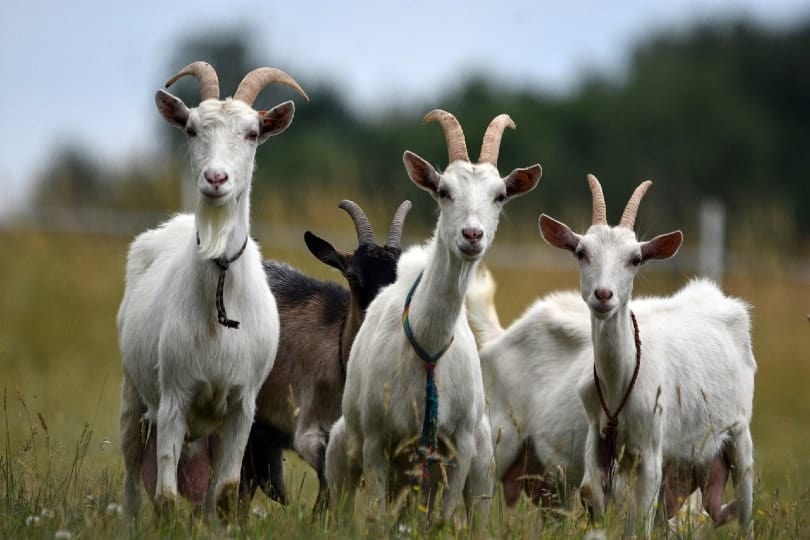
10. They Are a Whole Lot of Fun
I think we can all agree that goats may be one of the most fun and entertaining farm animals you can think of. From their looks to their antics, you can’t help but be amused by these incredible animals. Goats are playful, silly, inquisitive, and friendly but they are also very intelligent.
They have excellent long-term memory and are very independent learners. Don’t forget their vocalizations, which are somehow loud, obnoxious, and very enjoyable. There’s certainly a fair share of behaviors that can leave you belly laughing until it hurts.

The 14 Most Common Goat Breeds
1. Alpine
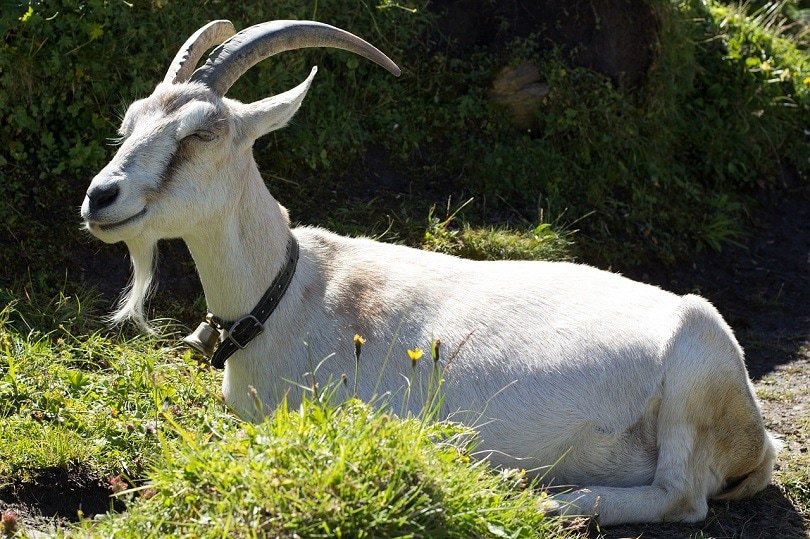
| Country of Origin: | France |
| Size: | 135-170 lbs |
| Purpose: | Dairy |
The Alpine is a breed of goat that originated in the French Alps. They are very hard and adapt well to various climates. Their primary purpose is dairy production because they have ideal udder and teat shapes and are excellent milkers. The Alpine is variable in size, ranging anywhere from 135 to 170 pounds and standing at least 30 inches at the withers.
2. Nubian
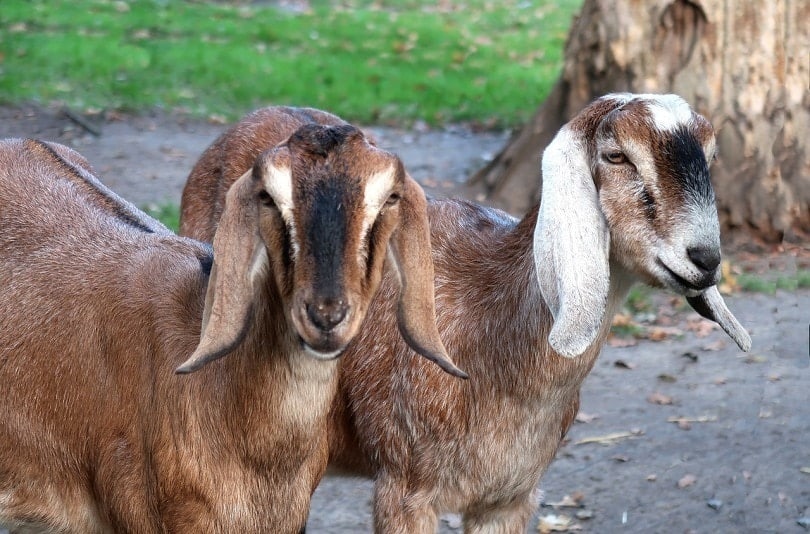
| Country of Origin: | United Kingdom |
| Size: | 135-175 lbs |
| Purpose: | Dairy |
Nubian goats originated in the United Kingdom during the 19th century when English goats were crossbred with lop-eared goats from India. They are the most popular goat breed used for dairy in the United States because they produce very high-quality milk. They are distinctly recognized by their long floppy ears and Roman nose.
3. La Mancha
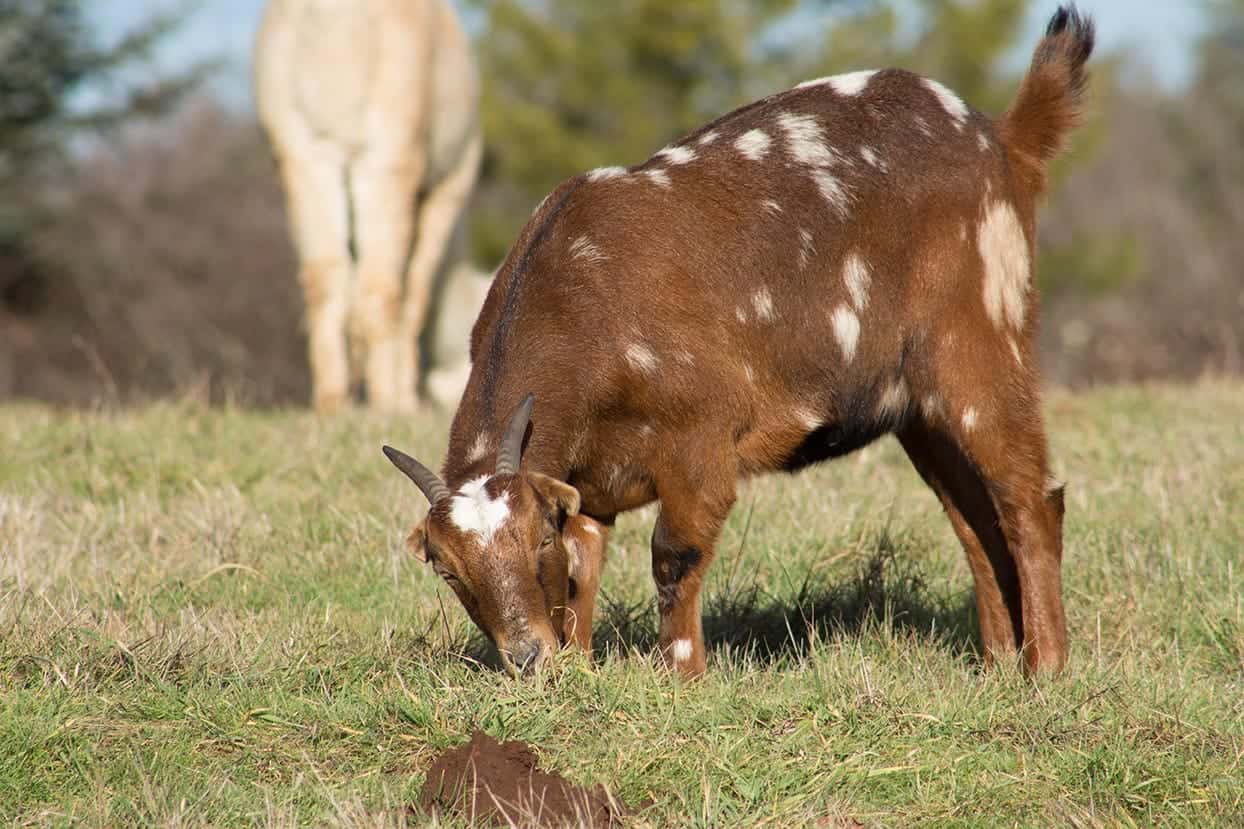
| Country of Origin: | United States |
| Size: | 130-165 lbs |
| Purpose: | Dairy |
The La Mancha have distinct short ears and are average-sized. They were developed in the United States but are believed to be descended from the Spanish Muricana goats from Mexico and the Criollo goats of South America.
4. Saanen (Sable)
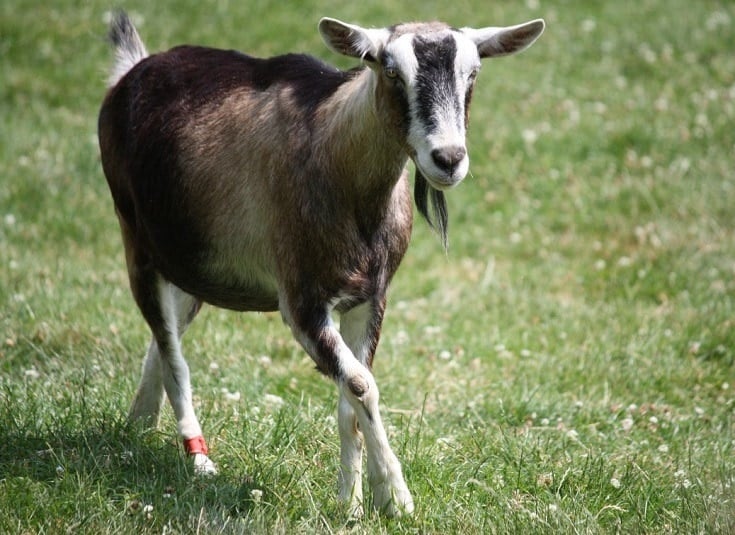
| Country of Origin: | Switzerland |
| Size: | 130-145 lbs |
| Primary Purpose: | Dairy |
The Saanen are large dairy goats that originated in Switzerland but are widespread throughout the world. They can produce nearly double the amount of milk than your average breed, making them among the most popular milkers. The Sable breed was derived from the Saanen and is the result of recessive genes related to coat color.
5. Boer
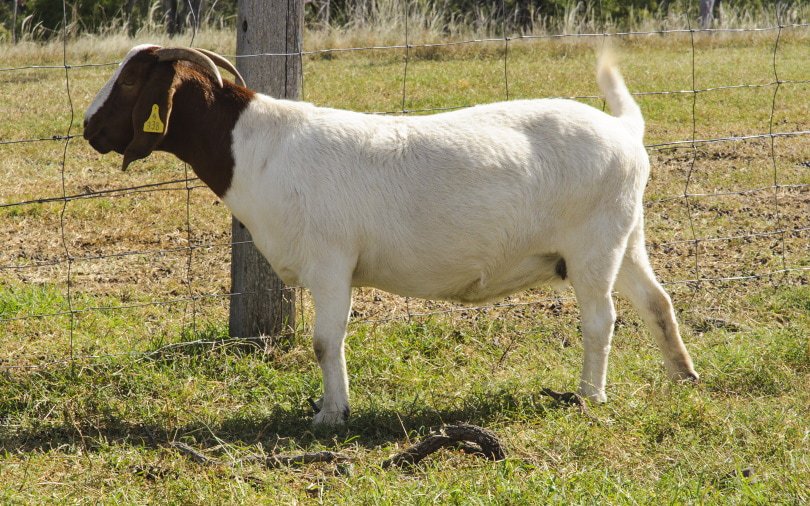
| Country of Origin: | South Africa |
| Size: | 200-300 lbs |
| Primary Purpose: | Meat |
The Boer goat comes from South Africa and made its way to the United States via importation in the 1930s. They are very large and have a very fast growth rate, making them incredibly popular meat goats. They are also very docile and are typically very easy to handle.
6. Spanish
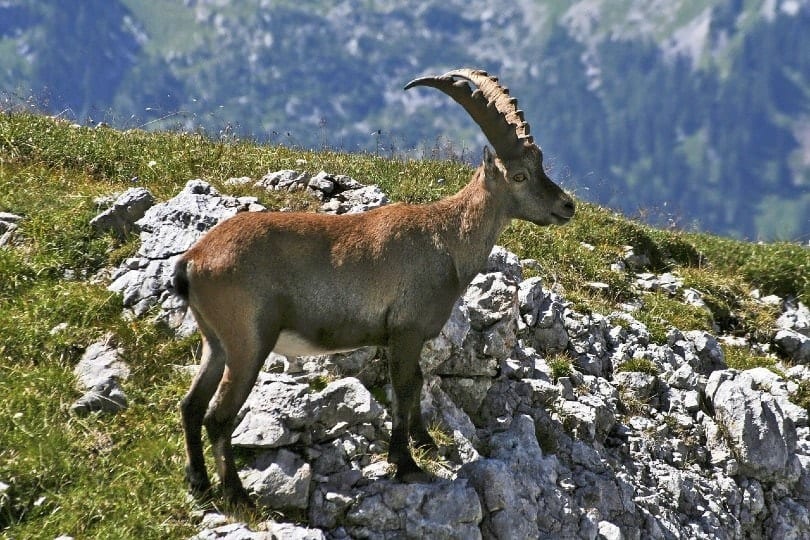
| Country of Origin: | Spain |
| Size: | 50-200 lbs |
| Primary Purpose: | Milk, Meat |
The Spanish goats are the result of a feral population that was forced to become hardy to survive. These goats are excellent mothers and can be sustained on little food. They are one of the most self-sufficient goats breeds you’ll find. They are raised for meat and milk but are often cross-bred to enhance both purposes.
7. Kiko
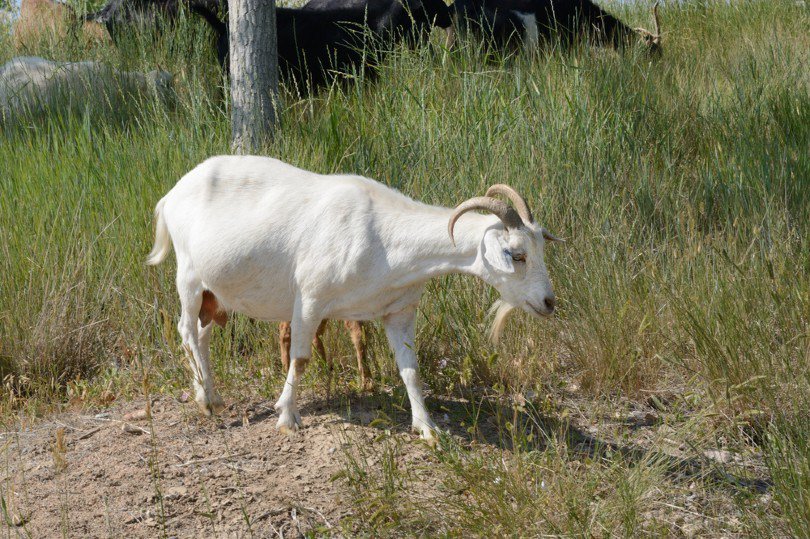
| Country of Origin: | New Zealand |
| Size: | 100-300lbs |
| Primary Purpose: | Meat |
The Kiko is a New Zealand goat breed that is popular for its hardiness. They easily adapt to various climates and can tolerate harsh weather conditions. They are a bit more difficult to manage because of their tempers, so they are often bred with Boers to offset those traits. They are commonly used for meat since they are sizable and grow rather quickly.
8. Toggenburg
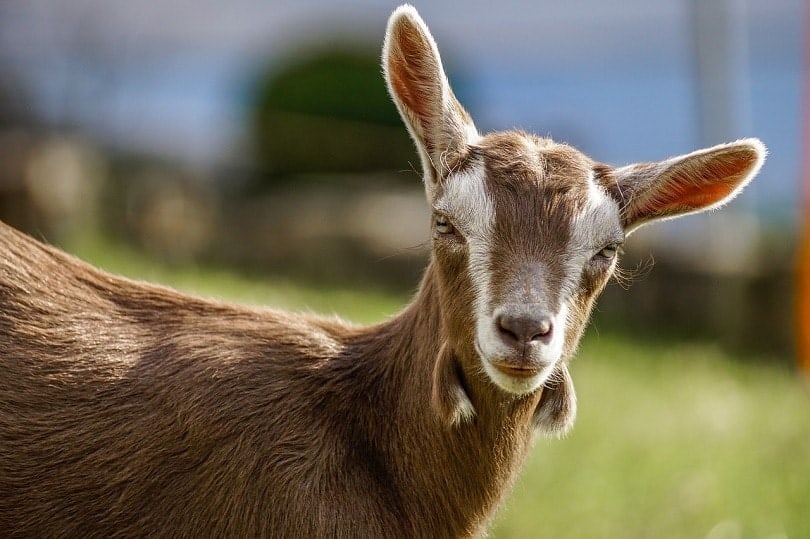
| Country of Origin: | Switzerland |
| Size: | 120-150 lbs |
| Primary Purpose: | Dairy |
Toggenburg is a Swiss breed that is known for its milk production. They are among the best-producing breeds in the nation. They are docile, easy to handle, and quite sturdy for their average size. They were some of the first dairy goat breeds brought into the United States.
9. Tennessee Fainting Goat
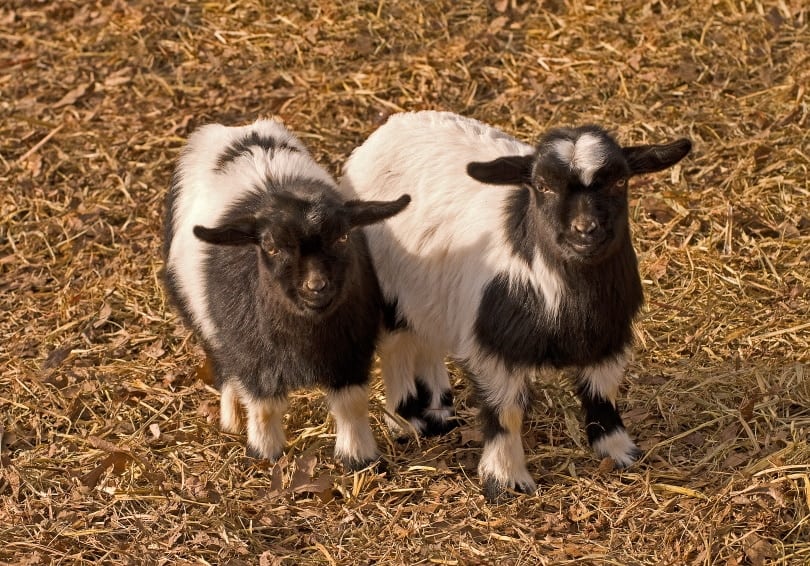
| Country of Origin: | United States |
| Size: | 50-175 lbs |
| Primary Purpose: | Companion, Meat |
The Tennessee Fainting goat, also known as the Myotonic goat, has a recessive gene that causes its muscles to stiffen when they are startled. It causes them to fall over like they would if they had fainted. The condition is not harmful to the goat’s physical health but does leave them vulnerable to predators. They are most often used as companions, but their dense muscles also make them a popular meat goat.
10. Nigerian Dwarf
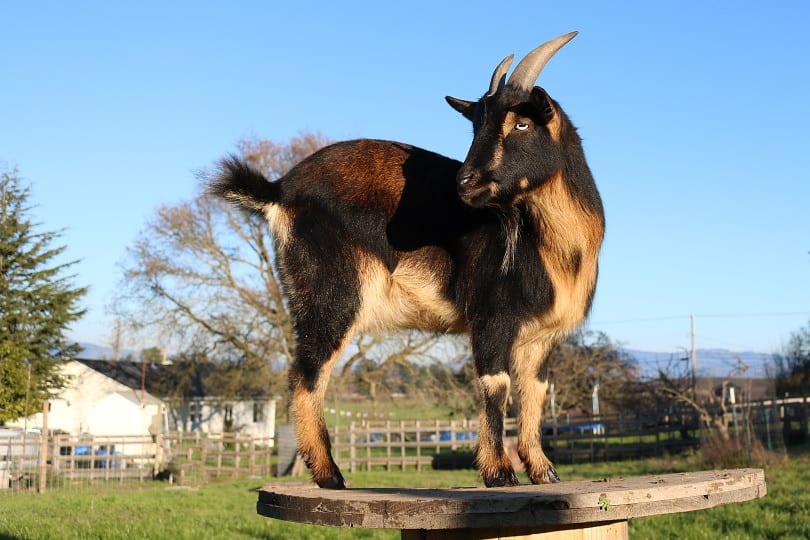
| Country of Origin | West Africa |
| Size: | 40-60 lbs |
| Primary Purpose: | Milk, Companions |
The Nigerian dwarf goat is a direct descendant of the West African Dwarf goat. They are very small when compared to other breeds and get a lot of attention for being so darn cute. They were used for milk and meat in their homeland but are most often used for shows and companionship in the United States.
11. Pygmy Goat
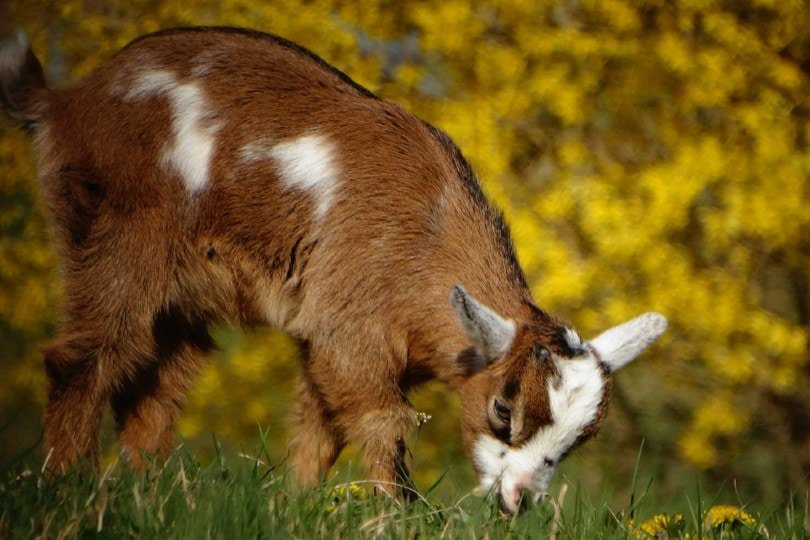
| Country of Origin: | Africa |
| Size: | 35-60 lbs |
| Primary Purpose: | Companion |
The African Pygmy Goat was first developed in Cameroon, Africa. They were originally considered exotic animals in the United States and were very common in zoos. They are small but might adapt well to a variety of climates. They are easy to keep and make great companions and milkers, though some do like to use them for meat, too.
12. Angora
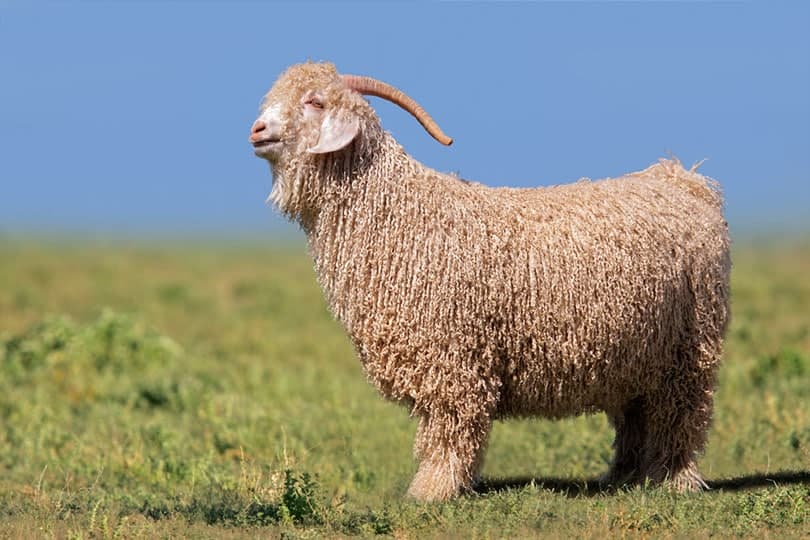
| Country of Origin: | Turkey |
| Size: | 70-225 lbs |
| Primary Purpose: | Fiber |
Angora goats are the producers of the valuable fiber called mohair. This breed was first introduced into the United States in the 1800s but dates back to ancient Turkey. Angoras are much more sensitive to weather conditions and parasites than other breeds. They are shorn twice each year and can produce up to 5 pounds of mohair per sheer.
13. Oberhasli
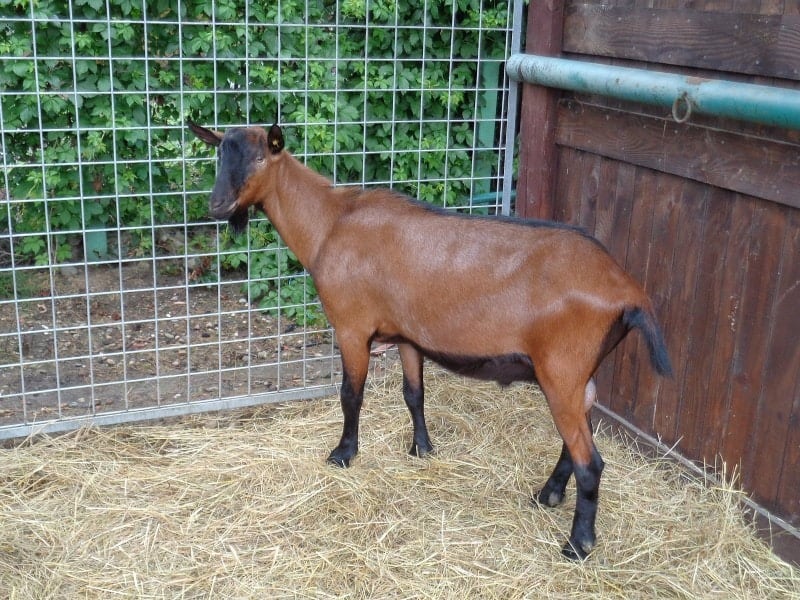
| Country of Origin: | Switzerland |
| Size: | 100-150 lbs |
| Primary Purpose: | Milk, Packing |
The Oberhasli is native to Switzerland and is known for being friendly and calm. They are most often used as dairy goats but also make great pack animals because they are much more fearless when compared to other breeds.
14. Savannah
| Country of Origin: | South Africa |
| Size: | 125-250 lbs |
| Primary Purpose: | Meat |
Savannah goats originate from South Africa. They are a hardy breed that is well adapted to arid climates with intense, unpredictable weather patterns. These goats have black skin and white coats and weigh anywhere between 125 and 150 pounds. They are a fertile breed that is relatively easy to care for.

Conclusion
Goats are a very versatile form of livestock that are pretty easy to care for and inexpensive to keep. They make great starters for those getting their toes wet into farming and can be used for dairy, meat, fiber, and as companions. There are a wide variety of purebreds and crossbred goats available throughout the country that each have unique traits to offer.
Related Read:
- 8 Health Benefits of Goat Yoga: A Fun Activity For Mental Health
- 20 Essential Goat Supplies to Get You Started: Vet-Reviewed Guide
Featured Image Credit: Barilo_Picture, Shutterstock
